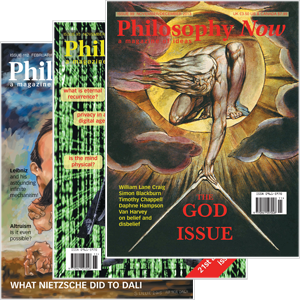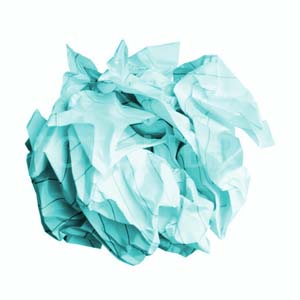
Your complimentary articles
You’ve read one of your four complimentary articles for this month.
You can read four articles free per month. To have complete access to the thousands of philosophy articles on this site, please
Fiction
The Great Crumpled Paper Hoax
A fantasy by Martin Gardner.
“The trouble with your art,” said Hazel, my significant other, “is that you don’t have a gimmick.”
It was a hot day in July. I was sitting opposite Hazel in a small basement bar in Soho, on Manhattan’s lower east side. Above us was the Archibald Gallery, where fourteen of my paintings were hanging. It was my first one man show.
The exhibition had been a colossal failure. Only one newspaper, the New York Times, covered the show, and the art critic who reviewed it called it “the most vapid show” he had seen in decades. Not a single picture sold.
“It’s not just that you don’t have a gimmick,” Hazel went on. She had an annoying habit of always saying exactly what she was thinking, even when it pained a listener: “It’s not just that you need something to distinguish your work from everybody else. It’s that you never learned how to draw.”
I winced and put down my glass of beer. Hazel was telling it like it was. I couldn’t paint a decent-looking cow if my life depended on it.
“You’re right as usual, my love,” I said. “But what can I do? I refuse to get up at six every morning to go to a job I hate – a job that can’t lead anywhere.”
“If you want my advice,” she said, “which I doubt… Forget about landscapes and realism. Go abstract. If your painting is totally non-objective, nobody can tell whether it’s good or bad. But you have to have a gimmick. You have to have something everyone will recognise as your trademark, a unique selling point.”
“Gimmick’s a good word for it,” I said. “Did you steal it from that magician friend of yours? Well, I’ve racked my brain for a fresh gimmick for years. But it ain’t easy to think of one. I can’t paint each one a different color, for instance. That’s been done. And I can’t slash the canvas with fat blue brush strokes like Klein, or paint the canvas a solid color like Reinhardt, or glue broken dishes to the canvas, or decorate it with elephant dung…”
Hazel flourished her empty glass as signal to the bartender. “Well, keep trying. Have you thought of moving from paint to minimalist sculpture?”
“Like Andre’s pile of bricks?”
“Yes, like Andre’s pile of bricks.”
I paid the tab and we parted: Hazel to her basement brownstone apartment, I to my lonesome loft in Brooklyn.

Next morning, during breakfast, I read another review of my show. It was even more scathing than the first. The Brooklyn Eagle wondered “Is the show a deliberate joke?” I ripped out the double pages, crumpled them into a ball, and hurled the ball across the room. It struck a wall then bounced to the uncarpeted floor, where a sunbeam from a skylight turned the air to dust and the paper to gold.
‘It’s beautiful,’ I said to myself, ‘like a yellow diamond’. I was reminded of G.K. Chesterton’s line, “all is gold that glitters.” Suddenly a bizarre thought bombarded my brain. I leaped to my feet. “ Eureka!” I shouted. “I’ve found my gimmick!”
With trembling hands I picked up from the kitchen counter a vertical spike mounted on a wood base that I use for spearing grocery receipts. I removed the receipts, retrieved my crumpled sphere, then pushed it down partway onto the spike.
Next, I sprayed the ball a bright blue. From a distance it looked like a NASA photograph of the Earth – only an Earth with a lovely crumpled surface.
The following day I showed the construction to my cousin Archibald. “Magnificent!” he exclaimed. “My gallery is booked through August and September, but in October I can display, say, a dozen of your new works. Of course, you’ll have to change your name.” So I changed my name from Joseph Johnson to Francis Feemster.
The October show was a huge success. The New York Times critic warbled about how my crumpled paper modeled the crumpled state of the Earth environmentally. All twelve of my spheres were sold. MOMA then bought a huge ball that I made from a complete Sunday edition of the Times, using glue to fasten the outer layers. For the Brooklyn Museum of Art I provided a large blue ball mounted on a spike, in turn mounted on a wooden cube that contained a tiny motor and two AA batteries. The motor rotated the ball slowly from east to west.
The following year I shifted to my pink period, followed by a multicoloured period, using crumpled Sunday comic pages. A Chicago manufacturer bought the rights to mass-produce the balls in colored plastic. Of course they sold for much lower than my originals. Time devoted three colorful pages to what they called ‘crumpled paper sculpture’. Feemster became famous.
After Hazel and I were married, we moved to a high-rise apartment on Charles Street in the Village. A well-known art critic is taping our conversation for a biography.
I’m now in my black period. The black symbolises the future of the Earth.
It goes without saying that Hazel and I have been extremely careful never to let on that crumpled ball art is a put-on. The deception continues to distress us. I’ve been drinking more booze than I should, and my dear wife is hinting that maybe it’s time to check into detox. If I drink myself to death, she tells me, she’ll see that a crumpled ball of concrete will rest on top of my tombstone.
© Martin Gardner 2022
The late Martin Gardner was an American popular mathematics and science writer, and a novelist, among many other things.









